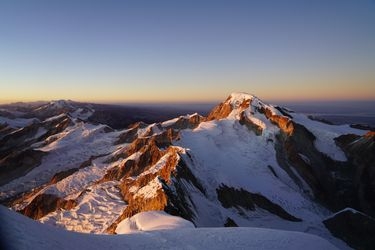Climbing Illimani





Illimani, a stunning peak in Bolivia, stands at an impressive 6,438 meters and remains the second-highest peak in the country. Its snow-capped summit is a beacon for climbers seeking a challenging yet rewarding ascent. The mountain's striking presence dominates the skyline of La Paz, offering a constant reminder of the adventure that awaits. The climb is non-technical but requires good acclimatization due to the altitude. The mountain's icy flanks and towering presence provide an exhilarating experience for those who venture to its heights.
The standard route, known as the West Ridge, offers a straightforward approach with a mix of snow and ice climbing. It begins from the base camp nestled at around 4,500 meters, progressing up to the high camp, Nido de Cóndores, at approximately 5,500 meters. The summit push involves navigating crevasses and steep snow slopes that demand both skill and stamina. Despite the lack of technical rock climbing, weather conditions can turn rapidly, adding an element of unpredictability to the climb. The panoramic views from the summit extend across the Andes, making the effort worthwhile for any seasoned mountaineer.
Illimani's allure lies in its combination of accessibility and challenge. While the ascent is feasible for those with experience in high-altitude climbing, it's essential to approach it with respect for the mountain and its conditions. The mountain’s weather patterns are variable, and climbers should be prepared for the rapid shifts that can occur. There are 8 guides available offering expeditions up Illimani, each providing an opportunity to experience the mountain's beauty and grandeur under the guidance of seasoned professionals.
Table of contents
Route
- 2,738 m gain over 3 - 5 days
- starting in Pinaya or Base camp if you drive up
- ending in Pinaya or Base camp if you drove up
- approach: walk in, drive
Walk in
- +700 m over a 12 km approach
- 0 - 1 days in
- 0 - 1 days out
Climb
- +2,038 m over 2 days.
- 1 high camp. Typically, climbers use the high camp at Nido de Cóndores (5500m) for acclimatization and the final summit push.
Difficulty
- PD: Not very hard (alpine grade 2)
- AD: Fairly hard (alpine grade 3)
When to go
- June to August
Permits
- 1 permit is needed
- costing around $7 total
These are pictures taken while climbing Illimani. They're shown here to give you an idea of what the route is like. You're welcome to share your own pictures of climbing Illimani, to help the community of climbers. Picture here are either uploaded by members (their own, or creative commons pictures), or guides.
Guide links
Illimani History
Climbing history of Illimani
The history of Illimani is as majestic as its towering peaks. The mountain has long been a significant landmark for the Aymara people, who have resided in the region for centuries, considering it a sacred mountain with spiritual significance.
One of the earliest recorded attempts to summit Illimani was in 1877 by Charles Wiener, a French explorer, although it was unsuccessful. In 1898, the first successful ascent was achieved by an American, William Martin Conway, with the help of his guide Maquignaz and a team of porters. This marked a pivotal moment in mountaineering history, as Illimani became a coveted summit for climbers worldwide.
The mountain's history is intertwined with the culture and traditions of the local people, who have adapted to the high-altitude environment over generations. Their rich heritage and enduring connection to Illimani add a unique dimension to the mountain's historical narrative.
 Base Camp
Base Camp
 Nido de Cóndores
Nido de Cóndores
 Summit
Summit
Either walk from Pinaya to base camp, or drive up if you have your own transport. From there it's a three hour walk up to high camp, and then around 5 hours to the summit.
Illimani weather
How is the weather on Illimani, and when is the best time to go.
The best time to climb Illimani is in these months:
- Jun
- Jul
- Aug
Illimani Services
Gear rental, porters, guides, transport, internet, accommodation
Accommodation
There's plenty of space to camp at base camp and high camp. Base camp has a good water source and toilets, and high camp there is ice/snow to melt.Guides
Many guides are available for this route.Porters
Porters can be arranged in Pinaya, the starting village. Either to base camp and high camp, or arranged just for base camp to high camp (and back).Illimani permits
What permits are needed for climbing Illimani
1. National Park Entrance Fee
- $7 (~50 in the local currency)
- This fee grants access to the national park area where Illimani is located.
- Can be purchased locally in the village of Pinaya.
Illimani access - getting there
How to get to Illimani
Illimani questions
What to know about climbing Illimani
Common questions people have about this trek, if yours isn’t here - add it to get an answer.
Illimani Links
useful websites, Groups and communities
Groups / links with more info on the Illimani route.
These climbs are similar in length, difficulty, and elevation. Offering a similar level of challenge as the Illimani climb.




